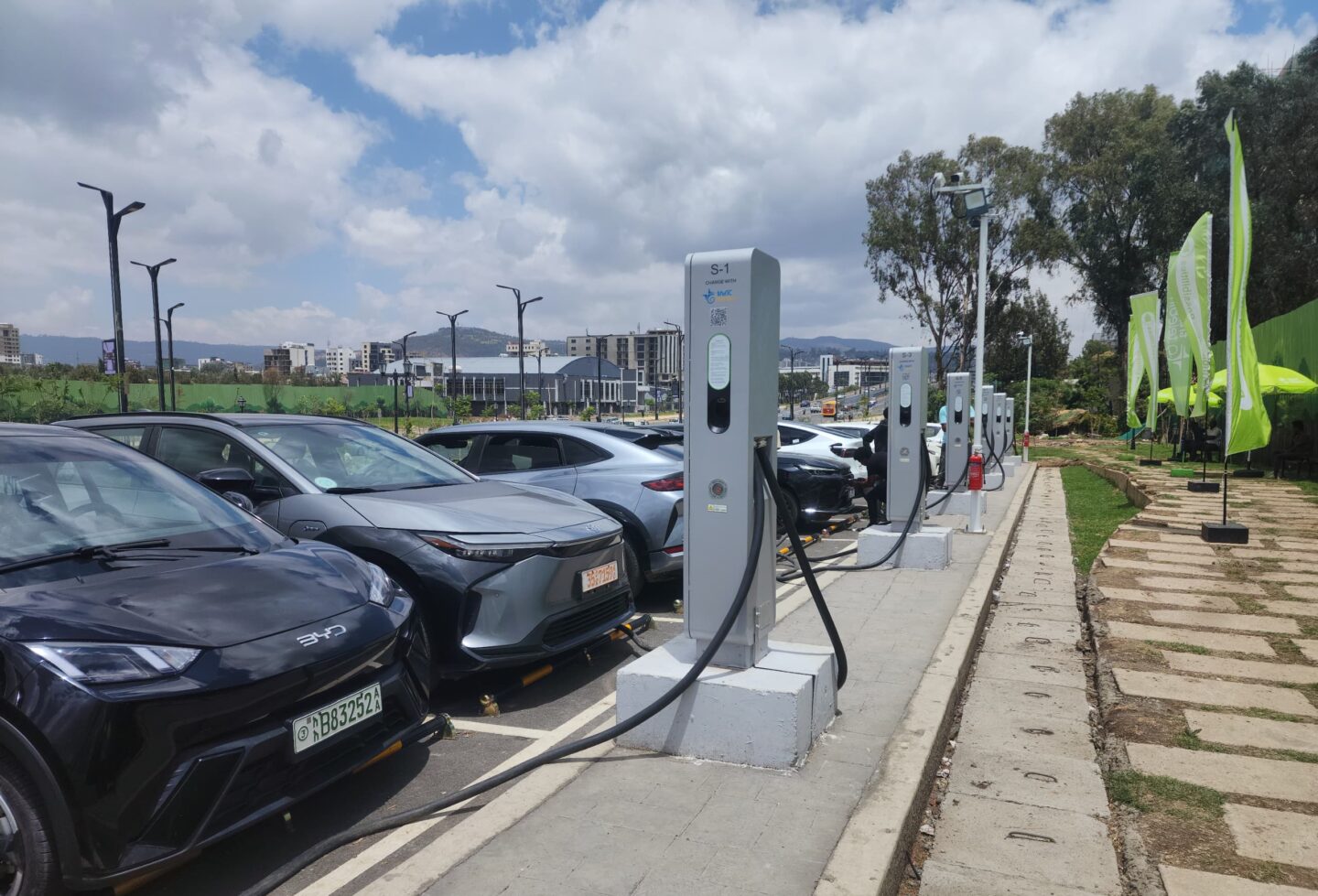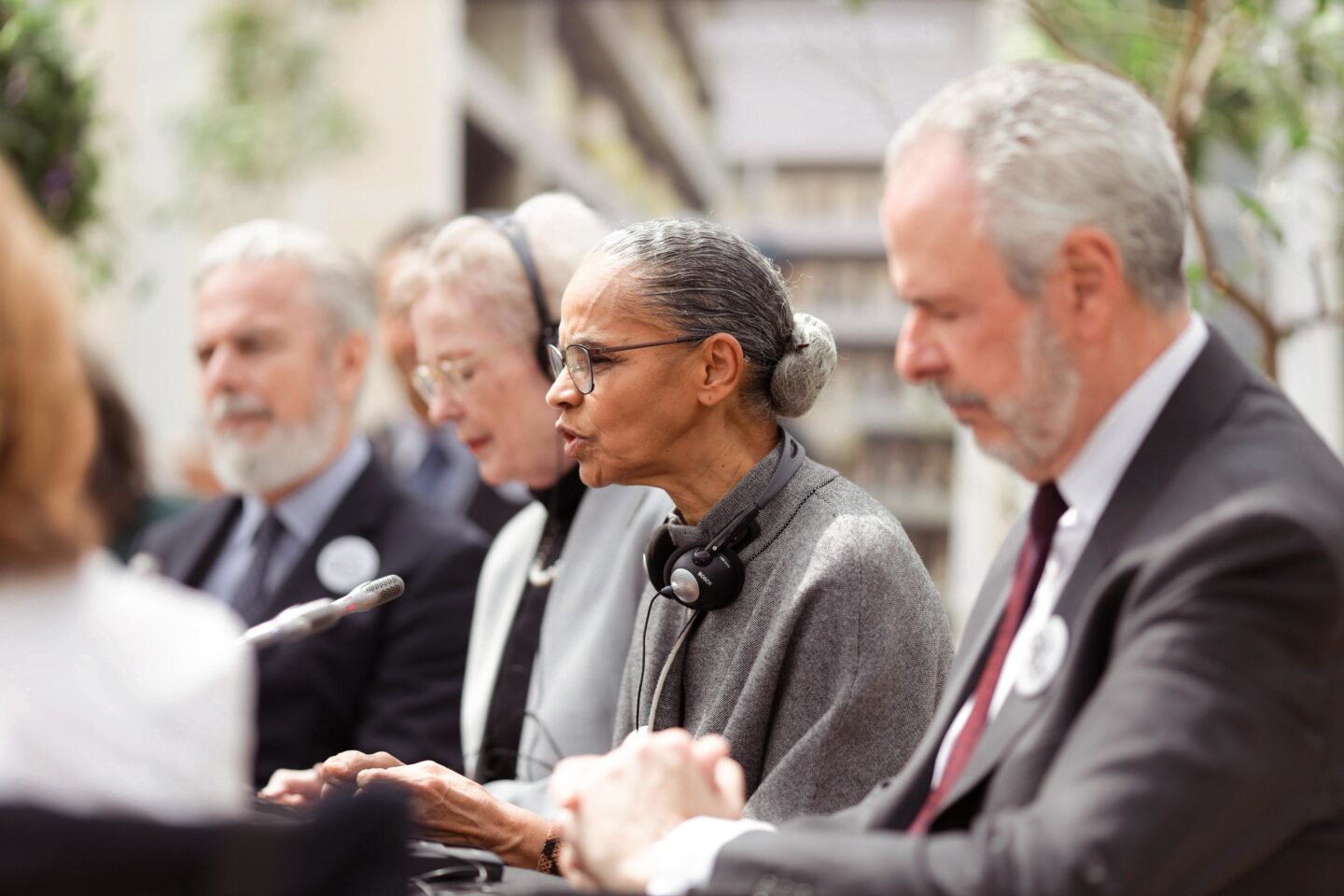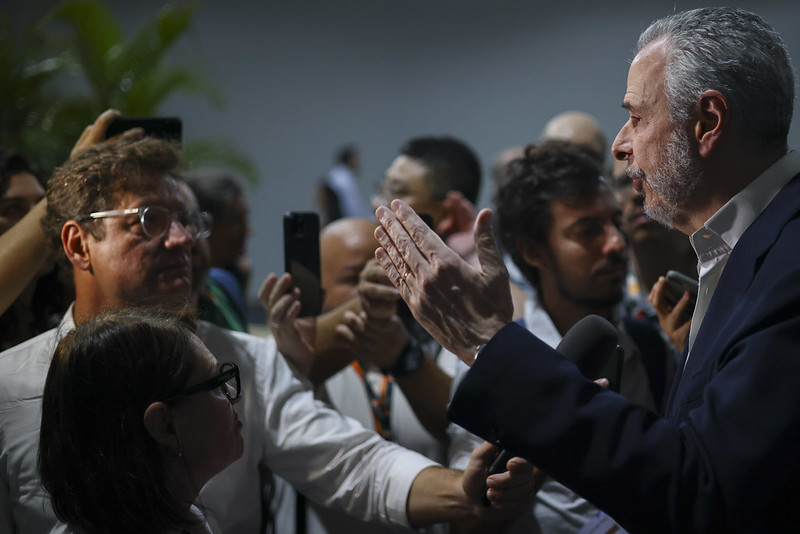About 9pm on Tuesday night, a group of protesters clashed with security guards as they attempted to force their way into the COP30 conference centre – making headlines and news bulletins around the world.
Videos captured dozens of mostly Indigenous demonstrators pushing through the main entrance, rushing past metal detectors, and demanding entry to the area where climate negotiators were meeting.
As UN security guards scrambled to stop them, scuffles broke out before the protesters were forcibly removed. A UN climate spokesperson said two security guards suffered minor injuries, and there was minor damage to the venue. One guard with a small cut told Reuters he was hit by a thrown drumstick.




Some of the protesters carried signs saying “our forest is not for sale” or demanding a halt to oil drilling in the Amazon rainforest.
“We can’t eat money,” Nato, an Indigenous leader from the Tupinamba community, told Reuters. “We want our lands free from agribusiness, oil exploration, illegal miners and illegal loggers.”
Brazil, the host nation of COP30, has underlined the importance of ensuring Indigenous communities have a voice in this year’s climate negotiations and there has been a record turnout of Indigenous groups in the city of Belém.
But, according to InfoAmazonia, Indigenous people are frustrated that more did not receive accreditation for the COP30 venue. Their analysis suggests 360 received accreditation. The Brazilian government says that’s more than any previous COP. But it’s only a small fraction of the 56,000 people registered to attend this year’s UN climate talks.
Lucas Tupinambá, a young leader from the Tapajós-Arapiuns Indigenous council, attended Tuesday’s plenary session after travelling for two days by boat to reach Belém. In his speech, he denounced the presence of dredgers extracting minerals in his region, but he told InfoAmazonia that “they are not interested in hearing from those who truly need to be heard”.
The Articulation of Indigenous Peoples of Brazil (APIB), the country’s leading Indigenous organisation, wants a strong outcome from COP30 on land demarcation to legally protect their land rights, which are threatened by loggers, agribusinesses and miners.
“Our core message is that demarcation and territorial protection are policies for facing the climate emergency. This needs not just to be acknowledged, but also implemented by global leaders—and in our case, above all, by Brazil,” Kleber Karipuna, APIB’s executive coordinator, told InfoAmazonia.
The post COP30 Bulletin Day 3: Protesters break into summit venue, clashing with security appeared first on Climate Home News.
COP30 Bulletin Day 3: Protesters break into summit venue, clashing with security
Climate Change
Countries Want Debt Relief for Conservation. Is China Ready to Play a Role?
“Debt-for-nature” swaps are helping some lower-income countries increase conservation. The world’s largest nation-state creditor has the leverage for deals—if it chooses to use it.
Planet China: Thirteenth in a series about how Beijing’s trillion-dollar development plan is reshaping the globe—and the natural world.
Countries Want Debt Relief for Conservation. Is China Ready to Play a Role?
Climate Change
A Messy Trail of Toxic Oil and Gas Waste
Go behind the scenes with managing editor Jamie Smith Hopkins and reporter Kiley Bense as they discuss how Pennsylvania is failing to track toxic oil and gas waste, while the amount sitting in landfills grows every year.
Pennsylvania is ground zero for the fracking boom. It’s increased natural gas production there 37-fold since 2008. That production generates a lot of waste, but the state’s ability to track it has failed to keep up.
Climate Change
Nine of our best climate stories from 2025
At Climate Home News, we found this year a pretty depressing one to cover, shaped as it was by Donald Trump’s attacks on climate science and action at home and abroad – and rounded off by the UN declaring global warming will break through the key 1.5C limit the world set itself in 2015.
But it wasn’t all bad. Nobody had decided to follow the US out of the Paris Agreement by the time it turned 10 this month. Anti-climate candidates in Canada and Australia, backed by Trump, lost elections convincingly. And 2025 may also have been the year carbon dioxide emissions fell for the first time.
What’s more, our reporting this year saw results in the real world. After we revealed that Chilean doctors believe pollution from copper mines in the northern hub of Calama is causing autism, campaigners sued state-owned mining company Codelco. The case is ongoing.
One of the lawyers representing the campaigners said “when [Climate Home News] revealed our silent suffering and our fight, we felt we had finally been heard and had entered the national conversation thanks to international media coverage. That was the final push to file the lawsuit.”
If you want to fund more impactful reporting like this in 2026, please subscribe and unlock all of our content for just the price of a coffee per week. Or to keep up with our latest coverage, you can sign up for our free newsletter and follow us on LinkedIn, Instagram, BlueSky and Facebook.
Below are nine of our best stories this year and, if that’s not enough, here’s nine more from 2024.
1. Solar squeeze: US tariffs threaten panel production and jobs in Thailand
In the year of trade wars, Trump extended Biden-era tariffs on solar panels from China to neighbouring countries. Nicha Wachpanich spoke to some of those workers who subsequently lost their jobs making panels at Chinese-run factories in Thailand and found that the US levies and bad behaviour by bosses had combined to crush their dreams of a better life.

2. Business-as-usual: Donors pour climate adaptation finance into big infrastructure, neglecting local needs
Trump being Trump, and axing US climate finance, is no reason to let other wealthy donor nations off the hook. We examined the latest spreadsheets for annual adaptation aid and found Japan is counting support for massive infrastructure projects in its figures, despite them having only a dubious role in helping people adapt to climate change.
Our reporter Tanbirul Miraj Ripon visited one such project – the Matarbari port in Bangladesh. He found that the port handles coal and gas imports and has destroyed locals’ homes and livelihoods. Despite this, on paper it represents $363 million in Japanese climate adaptation finance, the biggest single climate resilience project being funded by a wealthy country in 2023.
3. Ethiopia’s bold EV ambitions hit bumps in rural areas
Other nations are trying hard to go green but finding it tricky. This year, Ethiopia hosted the Africa Climate Summit, was selected as the host of COP32 and opened the continent’s biggest hydropower dam.
It plans to use some of this clean power to charge electric vehicles, after banning imports of cars with internal combustion engines (even as the European Union is softening its own 2035 ban on ICEs). While that will reduce Ethiopia’s already tiny emissions and its fossil fuel import bills, it won’t be easy in a nation where only half the population has electricity access, as Solomon Yimer and Vivian Chime reported.

4. Ending poverty and gangs: How Zambia seeks to cash in on the global drive for EVs
Other African governments are trying to cash in on their minerals, which big players like China, the US and increasingly Saudi Arabia want for green technologies and/or making equipment for wars.
Pamela Kapekele went to look at the situation in Zambia’s Copperbelt province – where you can probably guess what they produce! She found that good tax regulations and working conditions will be needed if locals are to see the benefits of surging demand for the metal.
Later in the year, an acid spill from a copper-mine tailings dam that contaminated the country’s main river showed the value of environmental regulation too. Reporting from Nigeria’s lithium and South Africa’s platinum mines also highlighted the challenges of making minerals mining and processing cleaner and fairer for communities.

5. Is the world’s big idea for greener air travel a flight of fancy?
Some sectors – like international aviation and shipping – tend to fall outside the scope of national media, and it’s a gap we’ve aimed to fill. Together with Singapore’s Straits Times, we tracked the supply chain for what the airline industry calls “Sustainable Aviation Fuel” (SAF) and found that virgin and barely used palm oil – which threatens rainforests – is being passed off as waste cooking oil and used to power planes in Europe.
Malaysia is a particular hotspot for this fraud, as government subsidies there make virgin palm oil cheap in the shops – and it can be sold for a higher price as “used” cooking oil, providing a profit motive for flipping it. Our investigation was picked up by the Financial Times, Bloomberg and the Malaysian authorities, who have since launched a crackdown on this kind of fraud.
But with verification of the materials used for SAF relying on just a handful of commercial auditors conducting mainly paper-based checks, airlines currently cannot know for sure if their green jet fuel is actually sustainable. Their advertising to passengers should – but often doesn’t – reflect this uncertainty.

6. Brazil’s environment minister suggests roadmap to end fossil fuels at COP30
Our reporting was often prescient this year. We called it correctly that the US would leave the Paris Agreement but not the UNFCCC, that Argentina would not follow America out of Paris, that Ethiopia rather than Nigeria would be chosen as COP32 host and that petrostates would try to kill a new green shipping framework at the International Maritime Organization.
We are also pretty sure we were the first – at least in English – to pick up on Brazilian Environment Minister Marina Silva’s proposal for COP30 to agree on a roadmap away from fossil fuels, which she aired back in June at London Climate Week. That proposal was pushed by President Lula at the start of COP30, dominated much of the conversation at the summit and will continue to be discussed throughout 2026.

8. PR firm working for Shell wins COP30 media contract
In the summer of 2025, our crack investigative reporter Matteo Civillini got the scoop on how the Brazilian government, via a contract tendered by the UN, was working with Edelman on international media relations for the COP30 climate summit while the global PR giant was simultaneously engaged in promoting Shell’s fossil fuel interests in Brazil.
This story was picked up by a range of other media, and amplified calls for agencies whose clients include fossil fuel firms to be excluded from the climate negotiations. Advocacy group Clean Creatives was inspired by Matteo’s reporting to launch a campaign against Edelman’s COP involvement. That culminated in an open letter from influencers and creators with a combined audience of over 24 million calling for Edelman to be dropped. The drumbeat on this theme is likely to get louder in 2026.

8. “House of cards”: Verra used junk carbon credits to fix Shell’s offsetting scandal
And talking of smoke and mirrors, just when we thought the murky web of carbon offsetting linking oil and gas major Shell to sham rice-farming projects in China couldn’t get any more convoluted, it did exactly that.
By combing through the records of carbon-credit registry Verra – the world’s biggest – Matteo confirmed that nearly a million bogus offsets from 10 disqualified methane reduction projects had been compensated for with the same number of junk credits from another four such projects that were also axed by Verra.
“It’s frankly unbelievable that Verra considers it appropriate to compensate for hot air credits with other hot air credits,” Jonathan Crook, policy lead at Carbon Market Watch, told us. “To pretend this is a satisfactory resolution is both absurd and deeply alarming.”
Verra insists the replacement credits were technically available to plug the gap left by the first batch – even though the second set, too, now need to be swapped out. Shell is keeping its distance, saying it does not manage or operate “the projects in question” despite being earlier involved in the Chinese rice-farming programmes as their “authorised representative”. Mind-boggling indeed!

9. Self-taught mechanics give second life to Jordan’s glut of spent EV batteries
In what was on balance a bad year, we brought you some hope too. A landmark advisory opinion on climate change and human rights from the International Court of Justice in The Hague was stronger than anyone imagined and may open the door to lawsuits against polluting countries and companies in 2026.
Other good news stories included analysts suggesting China’s fossil fuel use could peak this year, the UN’s loss and damage fund launching its first call for proposals, South Korea and Morocco moving to phase out coal and a boom in imports of solar panels to Africa.
Hope came too from ordinary people and their ingenuity – like the untrained Jordanians interviewed by Yamuna Matheswaran, hooking up solar panels to old Tesla batteries, lowering both their electricity bills and their carbon emissions into the bargain.

The post Nine of our best climate stories from 2025 appeared first on Climate Home News.
-
Greenhouse Gases4 months ago
Guest post: Why China is still building new coal – and when it might stop
-
Climate Change4 months ago
Guest post: Why China is still building new coal – and when it might stop
-
Climate Change2 years ago
Spanish-language misinformation on renewable energy spreads online, report shows
-

 Greenhouse Gases2 years ago
Greenhouse Gases2 years ago嘉宾来稿:满足中国增长的用电需求 光伏加储能“比新建煤电更实惠”
-
Climate Change Videos2 years ago
The toxic gas flares fuelling Nigeria’s climate change – BBC News
-

 Climate Change2 years ago
Climate Change2 years ago嘉宾来稿:满足中国增长的用电需求 光伏加储能“比新建煤电更实惠”
-

 Carbon Footprint2 years ago
Carbon Footprint2 years agoUS SEC’s Climate Disclosure Rules Spur Renewed Interest in Carbon Credits
-
Climate Change2 years ago
Why airlines are perfect targets for anti-greenwashing legal action

